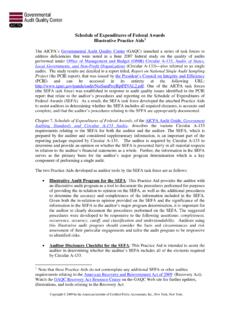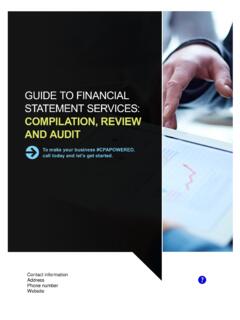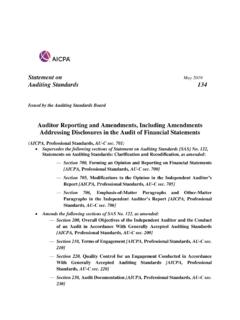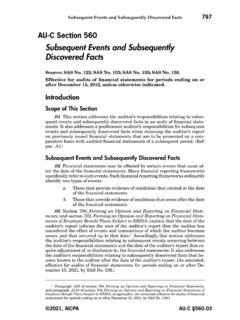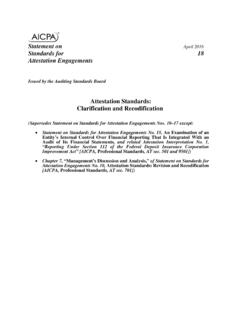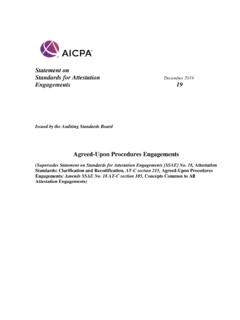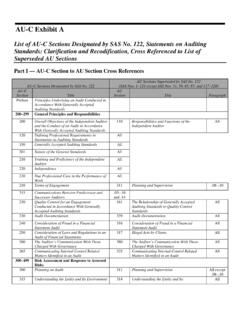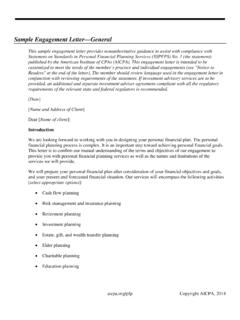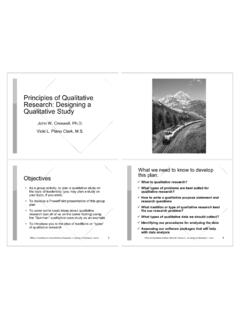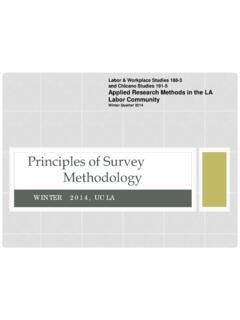Transcription of Tax Policy Concept Statement 1 Guiding principles of good ...
1 IGuiding principles of good tax Policy : A framework for evaluating tax proposalsTax Policy Concept Statement 1ii Guiding principles of good tax Policy : A framework for evaluating tax proposalsAbout the Association of International Certified Professional Accountants The Association of International Certified Professional Accountants (the Association) is the most influential body of professional accountants, combining the strengths of the American Institute of CPAs (AICPA) and The Chartered Institute of Management Accountants (CIMA) to power opportunity, trust and prosperity for people, businesses and economies worldwide.
2 It represents 650,000 members and students in public and management accounting and advocates for the public interest and business sustainability on current and emerging issues. With broad reach, rigor and resources, the Association advances the reputation, employability and quality of CPAs, CGMAs and accounting and finance professionals globally. About the American Institute of CPAs The American Institute of CPAs (AICPA) is the world s largest member association representing the CPA profession, with more than 418,000 members in 143 countries, and a history of serving the public interest since 1887.
3 AICPA members represent many areas of practice, including business and industry, public practice, government, education and consulting. The AICPA sets ethical standards for its members and auditing standards for private companies, nonprofit organizations, federal, state and local governments. It develops and grades the Uniform CPA Examination, offers specialized credentials, builds the pipeline of future talent and drives professional competency development to advance the vitality, relevance and quality of the the Chartered Institute of Management Accountants The Chartered Institute of Management Accountants (CIMA), founded in 1919, is the world s leading and largest professional body of management accountants, with members and students operating in 176 countries, working at the heart of business.
4 CIMA members and students work in industry, commerce, the public sector and not-for-profit organizations. CIMA works closely with employers and sponsors leading-edge research, constantly updating its qualification, professional experience requirements and continuing professional development to ensure it remains the employers choice when recruiting financially-trained business Overview Purpose of this tax Policy Concept Statement Guiding principles of good tax Policy Formulations of principles of good tax policy7 Explanations of the Guiding principles of good tax Policy Equity and fairness Certainty Convenience of payment Effective tax administration Information security Simplicity Neutrality Economic growth and efficiency
5 Transparency and visibility Minimum tax gap Accountability to taxpayers Appropriate government revenues 11 Challenges13 Conclusion14 Bibliography15 Notice to readersContents 2 Guiding principles of good tax Policy : A framework for evaluating tax proposalsOverviewPurpose of this tax Policy Concept statementDiscussions occur regularly among politicians, economists, tax practitioners and others about changing national and subnational tax systems. Any suggestion for modifying tax rules whether major or minor raises the question of how to best analyze and compare proposals.
6 A framework based on appropriate tax policies is needed to effectively analyze proposals to change tax rules and tax systems. Such a framework, based on widely accepted principles , also provides an objective approach for evaluating and improving existing tax principles of good tax Policy The Guiding principles , listed below, are commonly cited and used as indicators of good tax Policy . The first four principles are the maxims of taxation laid out by economist Adam Smith in his 1776 work, The Wealth of These principles , along with the additional eight, have been used for many years by governments, economists, tax advisers and The numbered order of the principles in this Statement is for reference only and is not an indication of the order of importance of these principles .
7 1. Equity and fairness Similarly situated taxpayers should be taxed similarly. 2. Certainty The tax rules should clearly specify how the amount of payment is determined, when payment of the tax should occur, and how payment is made. 3. Convenience of payment Facilitating a required tax payment at a time or in a manner that is most likely convenient for the taxpayer is important. 4. Effective tax administration Costs to collect a tax should be kept to a minimum for both the government and taxpayers. 5. Information Security Tax administration must protect taxpayer information from all forms of unintended and improper disclosure.
8 6. Simplicity Simple tax laws are necessary so that taxpayers understand the rules and can comply with them correctly and in a cost-efficient manner. 7. Neutrality Minimizing the effect of the tax law on a taxpayer s decisions as to how to carry out a particular transaction or whether to engage in a transaction is important. 8. Economic growth and efficiency The tax system should not unduly impede or reduce the productive capacity of the economy. 9. Transparency and visibility Taxpayers should know that a tax exists and how and when it is imposed upon them and Minimum tax gap Structuring tax laws to minimize noncompliance is Accountability to taxpayers Accessibility and visibility of information on tax laws and their development, modification and purpose are necessary for Appropriate government revenues Tax systems should have appropriate levels of predictability, stability and reliability to enable the government to determine the timing and amount of tax Adam Smith.
9 The Wealth of Nations, edited by Edwin Cannan, New York, The Modern Library, 1994, pages 887 to 8902 F or example, per the OECD: Assuming a certain level of revenue that needs to be raised, which depends on the broader economic and fiscal policies of the country concerned, there are a number of broad tax Policy considerations that have traditionally guided the development of taxation systems. These include neutrality, efficiency, certainty and simplicity, effectiveness and fairness, as well as flexibility. OECD, Addressing the Tax Challenge of the Digital Economy, 2014, page Guiding principles of good tax Policy : A framework for evaluating tax proposalsFormulations of principles of good tax policyThe following table shows how the Guiding principles correspond to commonly used formulations of criteria used to analyze tax principles of good tax policyOECD tax Joint Committee on Taxation (JCT) analysis Government Accountability Office (GAO) criteria for a good tax systemEquity and fairnessSee neutrality the tax system fair?
10 Does the tax system treat similarly situated individuals similarly? Does the tax system account for individuals different capacities to bear the burden of taxation? Equity includes two principles : (1) ability to pay (horizontal and vertical equity), and (2) benefits received. When making judgments about the overall equity of government Policy , it is important to consider both how individuals are taxed and how the benefits of government spending are distributed. CertaintySee simplicity of payment Compliance costs for taxpayers and administrative costs for the tax authorities should be minimized as far as possible.
